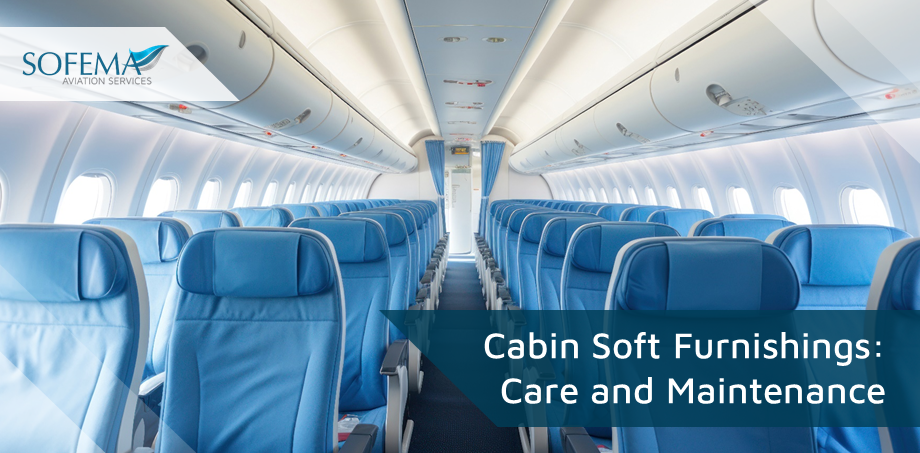Sofema Aviation Services (SAS) www.sassofia.com considers key aspects of cabin soft furnishings as well as best practices for effective cleaning and management
Introduction
Materials Commonly Used in Aircraft Furnishings
The choice of materials for aircraft cabin soft furnishings is a balance between comfort, aesthetics, and, most importantly, safety. Regulations ensure that these materials meet strict safety standards to protect passengers and crew in the event of emergencies.
Testing of aircraft soft furnishings is essential to ensure the safety and comfort of passengers. Proper interpretation of test results, combined with best practices, ensures that the materials used in aircraft interiors meet the highest standards
Aircraft interiors are designed to be lightweight, durable, and fire-resistant.
- Synthetic fabrics like polyester, nylon, and wool blends are often used for seat covers and curtains.
o These materials are chosen for their durability, ease of cleaning, and flame resistance.
- Polyurethane foam is a common choice for seat cushions due to its comfort and lightweight properties.
o Note that it must be treated or combined with fire-resistant materials to meet safety standards.
- Leather and Faux Leather are often used for premium seats due to their durability and luxurious feel. They are also relatively easy to clean and maintain.
- Nylon is a popular choice for aircraft carpets because of its durability and flame-resistant properties when treated appropriately.
Safety Implications and Regulations
Soft furnishings can pose risks, especially in the event of a fire. Therefore, strict regulations are in place to ensure that materials used in aircraft cabins are safe.
- One of the primary concerns with soft furnishings is their flammability.
- Materials must pass specific flammability tests to ensure they don’t ignite easily and, if they do, that they burn slowly and self-extinguish when the flame source is removed.
- In the event of a fire, materials can release toxic fumes.
o Regulations ensure that materials used in aircraft interiors have low toxicity levels when burned.
- In a fire, dense smoke can obstruct vision and hinder evacuation efforts.
o Materials are tested and regulated to ensure they produce minimal smoke.
- Materials must be durable to withstand regular use and cleaning without degrading their safety properties.
The FAA & EASA have established a series of tests and standards that materials must meet before they can be used in aircraft interiors.
- FAR 25.853: This is the FAA regulation that dictates the flammability requirements for materials used in the passenger compartments of transport category aeroplanes.
- FAR 25.856: This regulation pertains to the flammability of aeroplane interior materials when exposed to post-crash fire conditions.
Note: Fireworthiness Standards are harmonized across different jurisdictions to facilitate international aviation operations.
Testing Processes for Cabin Soft Furnishings
Aircraft soft furnishings, such as seat covers, carpets, curtains, and other textile components, are subjected to rigorous testing to ensure they meet the stringent regulatory requirements as well as to ensure the longevity of the materials.
Colour fastness Testing
- Common tests include exposure to light, rubbing (both wet and dry), and washing.
o The material is compared to a gray scale or color chart to determine the degree of color change or staining.
- Strength and wear testing to determine the durability and resistance of the material to wear and tear.
o The material is rubbed against a standard abrasive surface for a set number of cycles.
o The number of cycles it takes for the material to show signs of wear or for holes to appear gives an indication of its durability.
Fire Resistance Testing
- To ensure that the material does not easily ignite, spread flames, or release toxic fumes when exposed to fire.
o The material is exposed to a flame for a set period, and observations are made regarding ignition, flame spread, and smoke development.
o The material should not ignite or should self-extinguish within a set period. Smoke density and toxicity levels should be within acceptable limits.
Chemical Residue Testing
- To ensure that the material does not contain harmful chemicals or release them over time. (The concentration of chemicals should be below the set limits.)
o Analytical methods like gas chromatography or mass spectrometry can be used to detect residues.
Microbial Contamination Testing
- To ensure that the material is not contaminated with harmful microbes.
o Samples are cultured in growth media and observed for microbial growth. ( No growth indicates the material is free from contamination.)
General Best Practices
- Always ensure that the testing environment is controlled and free from external influences that could skew results.
- Use calibrated equipment and standardized procedures.
- Ensure that the samples being tested are representative of the actual product.
Cautions
- Always prioritize safety, especially when dealing with fire or harmful chemicals.
- Ensure proper disposal of test samples, especially if they are contaminated or have been exposed to harmful substances.
Next Steps
Follow this link to our Library to find & download related documents for Free.
Please see the following training course: Aircraft Servicing, Cleaning, and Detailing – 2 Days. For questions or comments please email team@sassofia.com
Tags:
Aircraft, aviation, aviation safety, EASA, Sofema Aviation Services, Regulatory Requirements, FAA, SAS blogs, Aviation Operations, Aircraft Cabin, Fireworthiness, Aircraft Servicing, Soft Furnishings, Aircraft Furnishing





